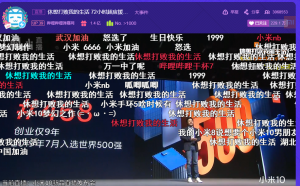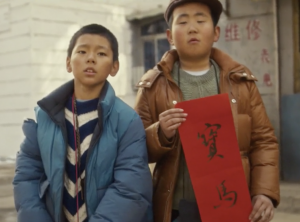
Kuaishou played a supporting role as sponsor of the 2019 CCTV Spring Festival Gala
Over the past five years, China’s Spring Festival holiday has become a battleground among the country’s biggest internet companies, and as new technologies such as short video become increasingly popular, the fronts are shifting.
Last week, China’s billion-user super-app WeChat faced a reckoning of sorts when Allen Zhang, the app’s founder, frankly discussed some of its shortcomings that have limited content creation. WeChat recently introduced several features to improve how content is seen and shared, and plans to add short-video functions in a new version of the app along with increasing its focus on monetization.
Rising competition and collaboration among Chinese technology, media and entertainment companies will be one of the most exciting trends to watch in 2020 and beyond. WeChat’s commitment to adding new features is one example of how it will try to retain users who are spending more time on Douyin, the current Chinese market leader for short video.
Tencent has also developed its own short-video platforms, of which Weishi is the most prominent, and is also hedging its bets with a growing stake in Kuaishou, the country’s number-two app for short videos — a recent report put its latest investment in Kuaishou in the neighborhood of $2 billion.
Kuaishou (the name means “fast hand”) originated as a photo-sharing app and pivoted to video in 2012, well before Douyin existed (at the time, Douyin parent Bytedance was focused on the development of its news aggregation app Jinri Toutiao, which became its first breakthrough app). Douyin appeared in 2016, and has since eclipsed Kuaishou in popularity, with a reported 400 million-plus daily active users (DAUs) at the end of 2019. Kuaishou, which is more popular in lower-tier cities and rural areas, reported around 200 million DAUs in mid-2019, and has stated a goal of hitting 300 million by the end of January 2020.
Kuaishou’s self-imposed deadline lands in the middle of China’s two-week-long Lunar New Year holiday period, which takes place earlier than usual this year. To hit its ambitious mark, Kuaishou nabbed a highly coveted deal to be the exclusive interactive partner for the CCTV Spring Festival Gala show, considered to be “China’s Super Bowl” for the huge audience it draws on the eve of the Lunar New Year. Last year’s show was reported to draw more than 1.17 billion aggregate views across platforms, far eclipsing the Super Bowl’s audience of around 100 million.
A crucial role of CCTV’s interactive partner is to give away money to viewers over the course of the broadcast through virtual “red packets” (红包) — essentially enticing viewers to both watch the gala and interact with the sponsor’s app in order to receive cash, while also tying into the deeply held cultural traditions associated with giving money in small red paper envelopes during the holiday. This is the first year that the interactive sponsorship has gone to a video app, as previous year’s partnerships have largely revolved around platforms with mobile payment capabilities such as WeChat and Alipay.
Kuaishou will make it fairly easy for viewers to get cash, requiring only that they watch a holiday-related video and like CCTV to receive a digital red packet, a departure from some increasingly complicated game-type giveaways of recent years. However, it is likely to put great pressure on Kuaishou to deliver on the content front — whether by promoting top creators or enlisting brands to participate.
The costs of CCTV’s partnerships have risen sharply since the practice started in 2015, when WeChat gave away RMB 500 million ($71 million) as the first interactive sponsor. Amounts given away have nearly doubled in the past two years, edging closer to RMB 1 billion ($143 million) amid heated competition to see which tech company can give away the most money. This year Kuaishou is aiming for a new record by surpassing RMB 1 billion with its virtual red packets. In addition, there are whatever undisclosed fees the Chinese state broadcaster collects as part of the deal, and another RMB 100 million ($14.3 million) in planned giveaways leading up to the January 24 gala.
Kuaishou was involved in last year’s Spring Festival gala as CCTV’s short-video partner, but the top “red packet partner” spot was claimed by Baidu. This year, Kuaishou reportedly beat out Baidu, Alibaba and e-commerce platform Pinduoduo for the honor of giving away heaps of cash during the show.
The splashy move into the big leagues of entertainment sponsorship is part of a broader effort to boost its standing among the fast-paced tech competition in China. In June, Kuaishou’s top leadership issued a battle cry for the company, noting that it’s corporate culture had become too laid back, allowing rivals to gain ground. While Kuaishou has rolled out a marketing platform and tools to help creators make money over the past year, it was reportedly taking a low-pressure approach to reaching its 2019 goal of RMB 15 billion ($2.1 billion) in advertising revenue. Meanwhile, Bytedance has surpassed Baidu and Tencent to become China’s second-largest digital ad player after Alibaba, and was reported to be on track to exceed RMB 140 billion ($20 billion) in revenue for 2019.
The competition won’t be sitting by as Kuaishou conducts its big Lunar New Year’s Eve giveaway. It remains to be seen whether Bytedance will top the RMB 1.6 billion ($230 million) it gave away across its apps last year, but it seems likely given the company’s phenomenal growth since then. And Alibaba recently announced that its main e-commerce platform Taobao will be the exclusive e-commerce partner for the CCTV gala show, offering to “clear shopping carts” worth RMB 49,999 ($7,240) for winners, while its flash sales platform Juhuasuan will offer discounts worth RMB 2 billion ($246 million) during the course of the event.





